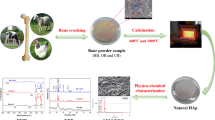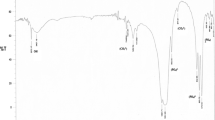Abstract
Bovine bone is one of the major sources for the extraction of hydroxyapatite (HAp). In the present study, HAp was extracted by thermal decomposition of pre-treated bones. Bones were first dual pre-treated using acetone and hydrochloric acid for the removal of fatty acid and proteins, respectively, and further calcined at 1000 °C to obtain HAp ceramics. Characterizations of the developed material were carried out to investigate its physicochemical properties using X-ray diffraction analysis (XRD), Fourier-transform infrared spectroscopy (FTIR), Scanning electron microscopy (SEM), Transmission electron microscopy (TEM), and Thermo-gravimetric analysis (TGA). Formation of HAp in the calcined powder was confirmed from XRD and FTIR analysis. Agglomeration of HAp particle with porous morphology was observed from SEM micrographs. The presence of calcium and phosphate in the calcined powder was further examined from Energy-dispersive x-ray (EDAX) spectrum with Ca/P ratio of 1.71. The ratio was fairly accurate to Ca/P ratio of human cortical bone. Average particle size of around 68 nm was calculated from TEM images using ImageJ software. Moreover, polycrystalline nature of the HAp was confirmed from concentric rings with bright spots as seen in the selective area electron diffraction (SAED) pattern of the calcined powder. The calcination of bone particles yields 23.31% HAp. The extracted HAp was found to have improved crystallographic property which is suitable for the development of artificial bone material and orthopedic implant coatings.
Access this chapter
Tax calculation will be finalised at checkout
Purchases are for personal use only
Similar content being viewed by others
References
Deb P, Deoghare AB, Borah A, Barua E, Lala SD (2018) Scaffold development using biomaterials: a review. Mater Today: Proc 5(5):12909–12919
Barua E, Deoghare AB, Deb P, Lala SD (2018) Naturally derived biomaterials for development of composite bone scaffold: a review. IOP Conf Ser: Mater Sci Eng 377(1):012013
Wang W, Yeung KWK (2017) Bioactive materials bone grafts and biomaterials substitutes for bone defect repair: a review. Bioact Mater 2(4):224–247
Bhui AS, Singh G, Sidhu SS, Bains PS (2018) Experimental investigation of optimal ED machining parameters for Ti-6Al-4 V biomaterial. FU Mech Eng 16(3):337–345
Lin K, Chang J (2015) Structure and properties of hydroxyapatite for biomedical applications. HAp Biomed Appl 4214(8):3–19
Muhammad N, Gao Y, Iqbal F, Ahmad P, Ge R, Nishan U, Rahim A, Gonfa G, Ullah Z (2016) Extraction of biocompatible hydroxyapatite from fish scales using novel approach of ionic liquid pretreatment. Sep Purif Technol 161(7):129–135
Mondal S, Mondal A, Mandal N, Mukhopadhyay SS, Dey A, Singh S (2014) Physico-chemical characterization and biological response of Labeo rohita-derived hydroxyapatite scaffold. Bioprocess Biosyst Eng 37(7):1233–1240
Ho WF, Hsu HC, Hsu SK, Hung CW (2013) Calcium phosphate bioceramics synthesized from eggshell powders through a solid state reaction. Ceram Int 39(6):6467–6473
Panda NN, Pramanik K, Sukla LB (2014) Extraction and characterization of biocompatible hydroxyapatite from fresh water fish scales for tissue engineering scaffold. Bioprocess Biosyst Eng 37(3):433–440
Rajesh R, Hariharasubramanian A, Ravichandran YD (2012) Chicken bone as a bioresource for the bioceramic (Hydroxyapatite). Phosphorous, Sulfur Silicon Relat Elem 187(8):914–925
Rana M, Akhtar N, Rahman S, Jamil HM, Asaduzzaman SM (2017) Extraction of hydroxyapatite from bovine and human cortical bone by thermal decomposition and effect of gamma radiation: a comparative study. Int J Comple Altern Med 8(3):00263
Khoo W, Nor FM, Ardhyananta H, Kurniawan D (2015) Preparation of natural hydroxyapatite from bovine femur bones using calcination at various temperatures. Proc Manuf 2:196–201
Gautam CR, Tamuk M, Manpoong CW, Gautam SS, Kumar S, Singh AK, Mishra VK (2016) Microwave synthesis of hydroxyapatite bioceramic and tribological studies of its composites with SrCO3 and ZrO2. J Mater Sci 51(10):4973–4983
Landi E, Tampieri A, Celotti G, Sprio (2000) Densification behaviour and mechanisms of synthetic hydroxyapatites. J Euro Ceram Soc 20:2377–2387
Pang YX, Bao X (2003) Influence of temperature, ripening time and calcination on the morphology and crystallinity of hydroxyapatite nanoparticles. J Euro Ceram Soc 23(10):1697–1704
Bains PS, Payal HS, Sidhu SS (2017) Analysis of coefficient of thermal expansion and thermal conductivity of bi-modal SiC/A356 composites fabricated via powder metallurgy route. https://doi.org/10.1115/ht2017-5122
Boudemagh D, Venturini P, Fleutot S, Cleymand F (2018) Elaboration of hydroxyapatite nanoparticles and chitosan/hydroxyapatite composites : a present status. Polym Bull. https://doi.org/10.1007/s00289-018-2483-y
Deb P, Deoghare AB (2019) Effect of pretreatment processes on physicochemical properties of hydroxyapatite synthesized from Puntius conchonius fish scales. Bull Mater Sci 42(3):1–9
Zhang Y, Yokogawa Y (2008) Effect of drying conditions during synthesis on the properties of hydroxyapatite powders. J Mater Sci Mater Med 19(2):623–628
Destainville A, Champion E, Laborde E (2003) Synthesis, characterization and thermal behavior of apatitic tricalcium phosphate. Mater Chem Phys 80(1):269–277
Wei M, Evans JH, Bostrom T, Grondahl L (2003) Synthesis and characterization of hydroxyapatite, fuoride-substituted hydroxyapatite and fuorapatite. J Mater Sci Mater Med 14(4):311–320
Sheikh FA, Yong H (2009) Extraction of pure natural hydroxyapatite from the bovine bones bio waste by three different methods. J Mater Process Technol 209:3408–3415
Manalu JL, Soegijono B, Indrani DJ (2015) Characterization of hydroxyapatite derived from bovine bone characterization of hydroxyapatite derived from bovine. Asian J Appl Sci 3(4):758–765
Xu JL, Khor KA, Dong ZL, Gu YW, Cheang P (2004) Preparation and characterization of nano-sized hydroxyapatite powders produced in a radio frequency (rf) thermal plasma. Mater Sci Eng, A 374(1–2):101–108
Mondal S, Mahata S, Kundu S, Mondal B (2010) Processing of natural resourced hydroxyapatite ceramics from fish scale. Adv Appl Ceram 109(4):234–239
Acknowledgements
The authors acknowledge Material Science Laboratory of Mechanical Engineering Department, NIT Silchar, for performing TG analysis. The authors thank SAIF, IIT Madras, Chennai, for performing SEM and FTIR analysis. The authors are grateful to SAIF, Gauhati University and CIF, NIT Silchar for XRD analysis of samples. The authors thank Indovation Laboratory and TEQIP III, NIT Silchar, for providing fund for the characterizations of the samples.
Ethical approval No Human/animal testing was performed during this study.
Author information
Authors and Affiliations
Corresponding author
Editor information
Editors and Affiliations
Rights and permissions
Copyright information
© 2019 Springer Nature Singapore Pte Ltd.
About this chapter
Cite this chapter
Barua, E., Deb, P., Das Lala, S., Deoghare, A.B. (2019). Extraction of Hydroxyapatite from Bovine Bone for Sustainable Development. In: Bains, P., Sidhu, S., Bahraminasab, M., Prakash, C. (eds) Biomaterials in Orthopaedics and Bone Regeneration . Materials Horizons: From Nature to Nanomaterials. Springer, Singapore. https://doi.org/10.1007/978-981-13-9977-0_10
Download citation
DOI: https://doi.org/10.1007/978-981-13-9977-0_10
Published:
Publisher Name: Springer, Singapore
Print ISBN: 978-981-13-9976-3
Online ISBN: 978-981-13-9977-0
eBook Packages: Chemistry and Materials ScienceChemistry and Material Science (R0)




